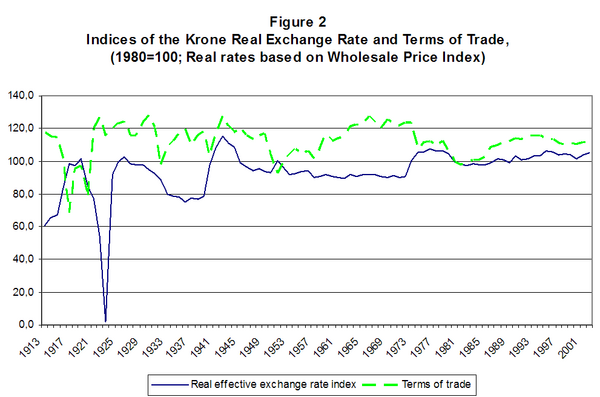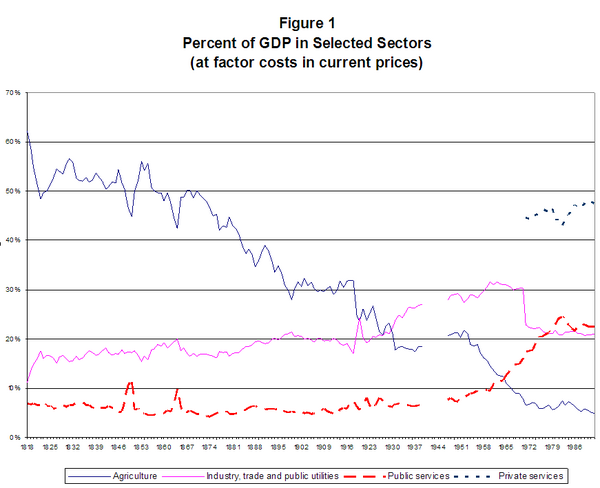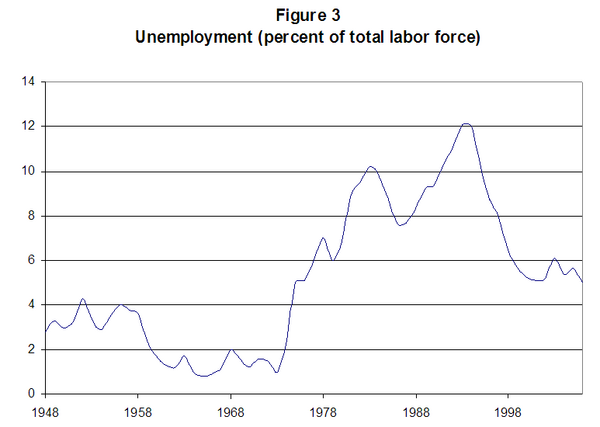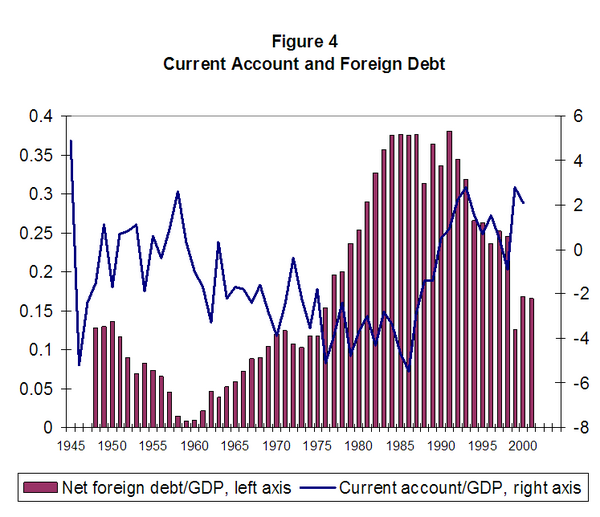Introduction
Denmark is situated in Northern Europe bordering Iceland, Germany and Sweden. The present day Denmark consist of Jutland Peninsula and Danish Isle which joined Denmark as a result of several cessions of territories of which Sweden which was part of the Danish territories but later on it separated from the Danish territory to form an individual unit when the Napoleon was conquered in 1814. Its total area covers about 43,000 square kilometers.
All through history, Denmark economic growth has been shaped by a number of factors that it has encountered. At present, Denmark is one of the leading economic superpower, with an approximate per capita income of $ 30,000 equivalent to 2.0% by the year 2004 as it can be shown in the table below.
Source: Backend.
Denmark’s physical location in the proximity of the Netherlands and the United Kingdom exerted an encouraging influence on the Danish economy development; with the Northern German influencing Denmark both through long-term economic ties, and through the Lutheran Protestant Reformation which the Danish embraced in 1536.
Traditionally, the Danish economy has been specializing in agriculture but of late its economy has become diverse to include manufacturing industry which has overtaken Agricultural sector as a major Danish economic element.
Looking at resource endowments, Denmark had previously no minerals to speak other than its relatively vast land for agricultural produce as compared to other European nations who had small agricultural land until 1972 when it discovered oil in the North Sea. To this point, to understand the economic history of Denmark and how it compares with other states economic status, it is good to know the various turning points of Denmark history which has shaped its economic development to the present.
End of Black Death and Revolution between 1500-1750
After the shocking consequences of the Black Death approximately in the year 1500, did population increase started to grow. The population growth subsequently was modest with at times fluctuating as a result of wars and prolonged periods of bad crop yields more especially during the seventeenth century. About 70 percent of the inhabitants practiced subsistence farming with little sells of grains to other countries estimated to be contributing about 6 percent to its national economy.
Following the year 1536, when the Lutheran was restructuring Denmark into to a protestant state, the Crown took over all church land, thus owning more than a half of all the land in Denmark and revenue income collected from these crown land and the duty collected from ships that passed through the Denmark waters served the cost of warfare during the sixteenth century.
Some fifty years later, the Crown depended on a great deal on estate owners to perform a number of important local tasks such as recruitment of warfare army, collection of land fees, and upholding the rule of law and order which enhanced the estate owner’s authority over their tenants, since it had already sold the crown land to the nobles and to some common owners of estates as a result of the financial crisis which hit Denmark (Backend Para. 3- 8).
Reforms and Global Market Integration between 1750-1870
The increasing number in population both at home and overseas during the seventeenth century acted as an impetus for Denmark economic growth which triggered technological and institutional reforms as old institutions setup such tax collection and binding of labor to land owners estate became obsolete.
Land reforms were carried out which advocated for scattering of the farm ownership to a larger population as compared to the previous century when land was owned by a few individuals. After the land and institutional reforms, there was an increase in the production per capita before the 1830s and the economy expanded further in the following years where new crops like clover and potatoes were introduced in large scale (Henriksen, P. 21-40).
The introduction of international free trade in the year 1796 marked the beginning of import taxes on imported goods due to the start of competition in export among the European nations on international market. But after Demark lost its long term export to Norwegian market in 1814 as a result of several Napoleons wars, it transferred its export to Britain market which was also in need of food to feed its growing population and animals
Rejuvenation to an Economic powerhouse between 1870-1914
During this period, Denmark economy outgrew that of most other European countries as its open market economy meet with those of the economically wealthy countries in the world such as Britain and the United States.
Early before the beginning of the First World War, it became the net importer of foreign capital and increased its foreign trade of agricultural produce with the help of agricultural cooperatives which acted as agents for bargaining price for its members export produce and enabled the middle-sized and small farmers to benefit from the economy of scale in processing.
In 1870s industrialization started to establish with a temporal speeding up of industrialization in the late 1890s. This was a as result of increased local demand for industrial goods with little industrial export which never surpassed 10 percent of value added before 1914. The export of agricultural products towards the end of the nineteenth century enabled the development of other economic sectors such as transport, trade and finance.
Period of First and Second World War, 1914-1945
From the start of the First World War, the Danes nonaligned themselves to neither German and its allies, nor to the Britain and it do allies which made it to enjoy economic benefits from both sides of the warring groups through its export of its products to both sides.
The subsequent export of surplus produce resulted to a monetary policy challenges as the monetary authorities failed to manage the high inflation rate resulting to a decline in value of the Krone by about 65 percent of its value before the start of the Second World War in 1920. Finally when monetary policy was tightened in 1924, the Krone started to appreciate and returned rapidly to its pre war uniformity as can be shown in the figure below

Source: Backend.
When the world depression hit Denmark, it gross domestic product declined by almost one-fifth but still agriculture employed one-third of the total workforce most probably because agricultural products made up 80 percent of total its export to other European nations of which they had been hit by the same depression hence, declining its export.
Denmark’s terms of trade declined sharply between 1930 and 1932 which forced it to sign new bilateral trade agreements between Germany and Britain, adopted exchange control, rationed import exchange to stem the net flow of foreign exchange out of the country and offer protection to domestic industry. Towards the beginning of the Second World War, Industrial sector, public sector gross national product had rose steadily and surpassed that of Agriculture as can be shown in the figure below.

Source: Backend.
Economic Crisis, Liberalizations and global Integration between 1950-1973
During this time, Denmark economic growth was markedly lower than the rest of the European countries. The reason being that there was a high share of agricultural goods in Danish exports accounting for about 63 percent and there was a large decline in the terms of trade as a result of Britain deflation in the year 1949 which Denmark followed suit.
The outburst of the Korean War in 1950, and the Suez conflict of 1956 made the economic crisis even worse resulting to deficits on the balance of payment and this forced the Danish authority to implement contractionary policy measures to contain further deficit growth.
In 1950, the Danish industrial sectors such as text tile industry which was protected through exchange control was hit a blow as a result liberalization of the flow of goods and capital in Western Europe but on the other hand, its export share of industrial production increased from 11 percent to 21 percent by the end of 1956.
As a result of market liberalization, Denmark joined up with its largest trading partner, Britain the European Free Trade Association created under British leadership in 1960 and later on Denmark followed Britain to join the European Economic Community after a referendum on the issue for economical gains of market liberalization.
The Shift from a Farming Society to Service Society
In 1960s, the importance of agriculture begun to decline as Danish agricultural exports were met with restraints from the European Economic Community and employment shifted to the public sector as it seemed more attractive than in the agricultural sector and another part of the work force shifted to building and construction industry hence, leaving manufacturing industry with a secondary position.
The sharp raise in welfare-related costs from the mid 1960s was the most noticeable even though the seeds of the modern Scandinavian welfare state were introduced much earlier.
During this period of welfare growth, public health care and education was introduced just like most of other European countries did. These social welfare programs targeted only the low income earners who were encouraged to take out insurance against sickness and unemployment which helped to caution high unemployment levels in the 1930s which was as a result of economic stagnation and the rise in population than what the economy can absorb as a work force.

Source: Backend.
Monetary and Macro-economic Policies
Denmark has been using the pegged exchange rate system based on united kingdom currency as it believed that for a small and open economy like hers, floating the exchange rate might cause a very high inflation and high interest rates which would harm its foreign trade and investments, after it abandoned using gold standard in 1931as its exchange rate value. But after the collapse of the fixed but variable exchange rates in the early 1970s, Denmark joined the European exchange rate cooperation which was formed in 1972.
The Deutschmark was effectively the nominal anchor in European currency cooperation until the launch of the Euro in 1999, a fact which put Danish competitiveness under pressure for the reason that it had noticeably higher inflation in Denmark compared to Germany and finally, the Danish government gave way before the pressure and undertook more than three distinct devaluations between 1978 and1981 because compensatory rise in wages were held back and the balance of trade improved appreciably (Abildgren, P. 59-65).
The expectations of more deflation mirrored for a sharp raise in the long-term interest rate and which at last peaked at 22 percent in nominal terms in 1982, combined with the effects of the second oil crisis on the Danish terms of trade and unemployment rose to 10 percent given to a higher compensation to unemployment, foreign debt and current debt which grew to 69 percent of its Gross Domestic Product in the early 1980s and late 1990s.

Source: Backend.
Current Economic Status of Denmark as Compared to other European States
The Danish economy has recently expanded rapidly enabled by private consumption growth, increase in exports and investment which has systematically modernized its economy features such as use of high technologic implements in agricultural production, well organized small-scale and corporate industry, extensive government welfare measures, better living standards and a stable currency as compared to other European nations which are still fighting out of the economic slow down.
Employment levels are high with an exception of capacity constraints which has acted as a limiting factor to its growth. At current, Denmark is the biggest exporter of agricultural produce and energy mostly to other European countries and enjoys an easy balance of payments surplus from its exports which has been necessitated by the government facilitating reforms to its governance structures.
The Danish government has been able to meet and even surpass its economic union criteria by taking part in the common European currency, but so far it has not decided to join the euro member states because it involves some political acceptance to join the union from the its citizen who must go for the referendum to decide whether to join it or not.
In terms of economic ranking, Denmark is ranked fifth in Europe with a gross domestic product in the end of year 2009 of $34, 7182 billions and a per capita of $62,015 Gross Domestic Product which is much higher than that of Sweden which is ranked fourteenth in Europe with a gross domestic product of $29, 537 Billions in the same year as shown below.
Source: Economy Statistics.
Conclusion
In conclusion, Denmark economic history can be back dated to many years ago. Starting form the agrarian revolution to industrial development, Denmark is now said to be one of the leading economies of the world.
Throughout history a number of advantageous factors have shaped the Danish economy starting from the first and Second World War where Denmark enjoyed trading benefits from both warring parties as it was a neutral state and also its embankment on the development of its capital capacity has been a factor to its economic development.
It expansion of the macro- economic policies have ensured a sustained economic growth, low unemployment rates, Social well being of its citizens and to a large extent maintained good international relationships with other countries for economic gains.
Recommendation
Demark has economically developed so much than most of the European countries due to its sound economic policy such as the monetary and fiscal policies which have been enabled it to control the inflation of its economy and its currency. However, to further its economic growth, Denmark needs to partner with other European Union to gain from the regional trade bock as a result of use of single currency. Hence, reducing its exchange burden since it also relies on export of its products.
Works Cited
Abildgren, Kim. “Real Effective Exchange Rates and Purchasing-Power-parity Convergence: Empirical Evidence for Denmark, 1875-2002.” Scandinavian Economic History Review 53.3 (2005): 59-65. Print.
Backend. “An Economic History of Denmark.” 2004. Web.
Economy Statistics :European countries by GDP per capita > GDP Per Capita (most Recent) by country. 2009. Web.
Henriksen, Ingrid. “Freehold Tenure in Late Eighteenth-Century Denmark.” Advances in Agricultural Economic History 2 (2003): 21-40. Print.